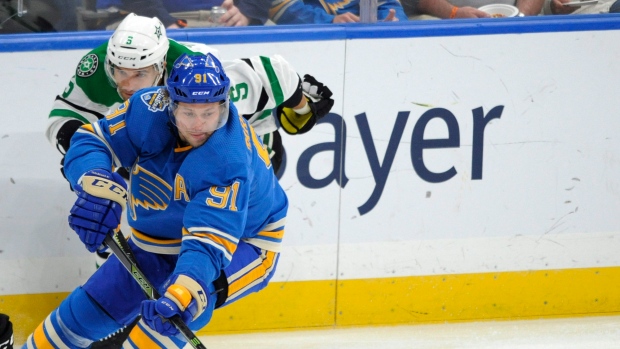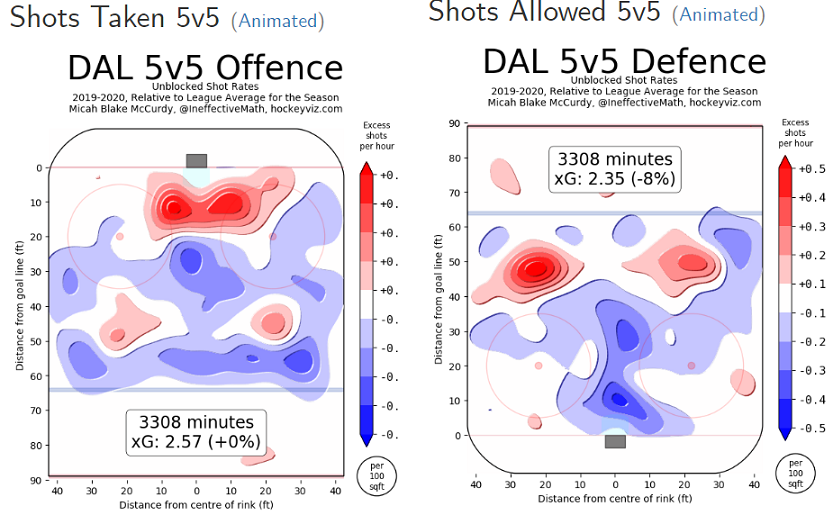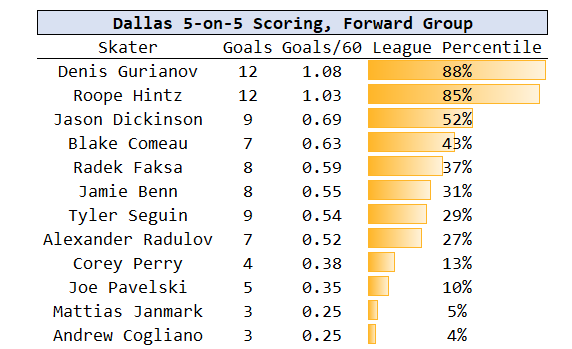Jul 16, 2020
Playoff Preview: Examining the best of the West
Four great teams awaiting round-robin action in the NHL's Return To Play and Travis Yost writes looks at critical questions facing each of them.
By Travis Yost

As part of the NHL’s return to play plan, we previewed each of the eight play-in round match-ups. The return to play previews were hopefully as exciting to read as they were to write. But we would be remiss if we did not overview the other eight playoff competitors – the eight presumptive Stanley Cup favorites waiting in the wings for their second-round foes.
On Tuesday, we looked at the biggest questions facing the round robin teams in the Eastern Conference. Today, we will look at their peers in the Western Conference, including the St. Louis Blues, Colorado Avalanche, Dallas Stars, and Vegas Golden Knights.
Team Performance, By the Numbers

Goalie Performance, By the Numbers

Skater Performance, By the Numbers

St. Louis Blues: How healthy is Vladimir Tarasenko?
It’s not the same as Colorado’s cluster injuries – more on that in a moment – but the return of Vladimir Tarasenko from a shoulder injury is a significant one. Tarasenko required five months of rehabilitation from the injury and subsequent surgery, and in a normal season, Tarasenko’s status for the post-season may have well been in jeopardy. In this case, the Russian sniper was given three more months to rehabilitate.
With Tarasenko sidelined for much of the season, head coach Craig Berube had to get creative with his top-six. The defending Stanley Cup champions have an embarrassment of riches when it comes to depth competency, but when it comes to best-on-best, they are heavily reliant on the likes of Tarasenko and two-way dynamo Ryan O’Reilly. Down Tarasenko, Berube thrust players like David Perron and Zach Sanford into bigger roles. Both played well, but replacing a player who has scored thirty or more goals in five consecutive seasons is an impossible ask for most teams in the league, even ones as deep as St. Louis.
If Tarasenko is healthy, his injection into the lineup will give the Blues some much needed scoring punch. If not, this Blues lineup – while still comparing quite favourably against most of the Western Conference – could be in tough against the round robin calibre teams.
Colorado Avalanche: Can Colorado make the most of their injury reprieve?
If there is a short list of Stanley Cup contenders, the Colorado Avalanche are on it. This line up is a far, far cry from the version we saw a couple of years ago – one heavily reliant on star players and relentless counterattacking. The 2019-20 version is an elite 5-on-5 hockey team with impressive skill and speed at every position; their 162 goals scored there were more than any other team in the National Hockey League. Behind their deep forward pool, the team has a blue line anchor in 21-year old Cale Makar, and their goaltending tandem of Pavel Francouz and Philipp Grubauer held up quite well.
And, they may be one of the few teams that benefited from such a long layoff.
One of the biggest reasons why the Avalanche were unable to create any sort of daylight in the Central division race was because of the injury bug. The team ranked fifth in man games lost this season with 222, with 169 of those games lost from their forward group. These weren’t immaterial injuries, either. Star Nathan MacKinnon was slated to miss time due to a lower body injury right before play was stopped. Grubauer, the team’s presumptive starting goaltender, was sidelined with Mikko Rantanen only played 42-games this season after missing extended time due to an upper body injury. Nazem Kadri (19-games), Andre Burakovsky (12-games), and Matt Calvert (20-games) all missed substantial time.
Despite such poor injury luck, the Avalanche finished fourth in the National Hockey League by standings points and third in sheer goal differential. And while the four-month layoff is sure to create some rust for teams across the league, one wonders if the stoppage of the season was a bit of a reprieve for an Avalanche team that needed to get healthy.
The healthy version of this team is, of course, quite good.
Dallas Stars: Where will the scoring come from?
In many ways, Dallas is Boston West – an impressive defensive team back-stopped by two strong goaltenders in Ben Bishop and Anton Khudobin. Only four teams gave up fewer expected goals per-60 minutes this season at even strength, and just two one team – the aforementioned Bruins – gave up fewer actual goals. For any Western Conference competitor, breaking through against the Dallas defence will be trying, and that alone makes them a credible threat this post-season.
But one wonders what will happen when Dallas faces teams around the league more capable at possessing the puck, more capable at holding the offensive zone for longer periods of time, and more capable of generating dangerous scoring opportunities from the interior. The only time Dallas appeared to be a broken team this season was when they were chasing the game, searching desperately for scoring opportunities of their own in the offensive end.
Whereas the strength of the Dallas club is their ability to limit both high quality chances and minimize the shot volume against, the weakness is their ability to generate anything meaningful in the other direction. Consider the heat maps of where shots come from with Dallas on the offensive and defensive side of the game – it is virtually a clone of one another:

What is most interesting is that the players historically doing damage for the Dallas forward group – Tyler Seguin and Jamie Benn being the two most obvious names – didn’t provide nearly as much scoring punch as expected. In fact, the only forwards who stand out in a positive light on a rate basis were Denis Gurianov and Roope Hintz – the only two players who grade out well relative to their peers around the league:

Vegas Golden Knights: Can this team make an uncomfortable decision in net?
The Vegas Golden Knights have been around for three seasons, and a face of the franchise has certainly emerged in goaltender Marc-Andre Fleury. In fact, Vegas’ inaugural Cinderella-type season was really driven by the performance of their star goalie – Fleury stopped a whopping 92.7 per cent of shots
But Fleury has simply not been the same goaltender during the 2019-20 regular season. Statistically speaking it was the worst year of his career, an ominous sign for 35-year olds who have played over a thousand NHL games. Fleury’s poor performance – along with the struggles of back-up Malcolm Subban, moved to the Chicago Blackhawks at the trade deadline -- was particularly noticeable on a Vegas team that may have the most talented lineup in the Western Conference.
Vegas still ended up winning the Pacific division, but the front office didn’t waste any time addressing the team’s most obvious concern. When the Golden Knights sent Subban (along with a 2020 second-round pick) to Chicago, they acquired Swedish goaltender Robin Lehner. Lehner has been working to secure a starter role for a few years now, and the numbers justify it – this season alone, his save percentage (92.0 in all situations) and goals saved above expectations (+5.0) ranked 10th in the National Hockey League.
In many ways, Lehner was a hired gun for this Vegas team. His contract expires at the end of the season, and Lehner could command starter money from any number of teams around the league. Head coach Peter DeBoer has inferred that both goalies would be used this post-season, but it will be fascinating to see who gets the high leverage starts. Fleury is the veteran, but Lehner is the better option.
Data via HockeyViz, NHL.com, Evolving Hockey, Hockey Reference


